At Best Cosmetic Hospitals, we understand that your face is the most expressive part of your body. It reflects who you are and plays a vital role in how you’re perceived by the world. Cosmetic facial surgery provides an opportunity to enhance, refine, and rejuvenate your facial features, helping you achieve a natural, youthful appearance that boosts your confidence and self-esteem.
Cosmetic facial surgery includes a variety of procedures, from subtle enhancements to comprehensive transformations, allowing patients to address concerns related to aging, asymmetry, or other aesthetic desires. With the advancement of modern techniques, facial surgery has become more refined and accessible, delivering stunning, natural-looking results with less downtime.
Cosmetic facial surgery is about more than changing your appearance—it’s about feeling confident and empowered in your own skin. Whether you want to restore a youthful look, correct facial imperfections, or enhance certain features, facial surgery offers a personalized approach to meet your aesthetic goals. Here are some reasons why individuals choose cosmetic facial surgery:

1. Reverse the Signs of Aging: Over time, the effects of aging become visible through fine lines, wrinkles, sagging skin, and volume loss. Cosmetic facial surgery offers solutions like facelifts, eyelid surgery, and brow lifts to turn back the clock, giving patients a more youthful and refreshed appearance.
2. Enhance Facial Features: Cosmetic facial surgery can enhance and refine features such as the nose, cheeks, jawline, and chin, creating harmony and balance in the face. Procedures like rhinoplasty (nose surgery) and chin augmentation allow patients to achieve facial symmetry and proportionality, improving both appearance and self-confidence.
3. Correct Facial Imperfections: Some individuals seek cosmetic facial surgery to correct congenital defects, such as a cleft lip or ear deformities, or to address issues caused by trauma or previous surgeries. Procedures like otoplasty (ear surgery) or scar revision can restore natural contours and improve facial aesthetics.
4. Boost Self-Confidence: Cosmetic facial surgery can have a profound impact on self-esteem, allowing patients to feel more comfortable and confident in their appearance. Whether it’s a subtle enhancement or a dramatic transformation, the results of facial surgery can positively affect both personal and professional interactions.
5. Achieve Long-Lasting Results: Facial surgery provides long-lasting solutions to aesthetic concerns, offering durable improvements that can be maintained with proper care. While non-surgical treatments like Botox and fillers provide temporary enhancements, facial surgery offers more permanent results for those seeking a lasting change.
Cosmetic facial surgery encompasses a variety of procedures designed to enhance or restore different areas of the face. Here’s an overview of the most popular facial surgeries offered by top surgeons worldwide:
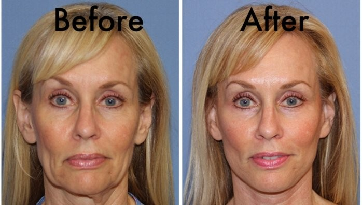
A facelift is one of the most popular cosmetic surgeries for reversing the signs of aging. It involves tightening the skin and underlying muscles of the face and neck to smooth out wrinkles, eliminate sagging, and restore a youthful contour. A facelift can also be combined with other procedures like eyelid surgery or brow lifts for comprehensive facial rejuvenation.
Individuals experiencing sagging skin, deep wrinkles, or jowls
Patients seeking to restore a youthful appearance to their face and neck
People looking for a long-lasting anti-aging solution
During a facelift, incisions are typically made around the ears and hairline to lift and reposition the skin and tissues of the face. Excess skin is removed, and the remaining skin is tightened for a smoother, firmer appearance. Recovery from a facelift takes about two to three weeks, with results lasting up to 10 years or more.
Rhinoplasty, also known as a nose job, is a surgical procedure that reshapes or resizes the nose to enhance facial harmony. It is one of the most common cosmetic facial surgeries and can address aesthetic concerns such as a crooked nose, a prominent hump, or a bulbous tip. Rhinoplasty can also correct functional issues, such as breathing problems caused by a deviated septum.
Individuals unhappy with the size or shape of their nose
Patients with structural issues that affect breathing
People seeking a more balanced, symmetrical facial profile
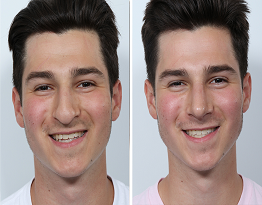
Rhinoplasty can be performed using an open or closed technique, depending on the patient's needs. The surgeon reshapes the nasal structure by removing or rearranging cartilage and bone. Recovery takes about one to two weeks, with final results becoming apparent after the swelling subsides.
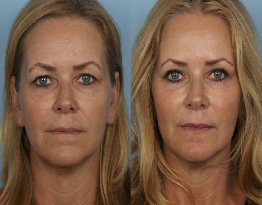
Eyelid surgery, or blepharoplasty, is a procedure that removes excess s kin, fat, and muscle from the upper and lower eyelids. This surgery addresses droopy eyelids, puffiness, and under-eye bags, creating a more youthful and alert appearance.
Individuals with sagging or droopy eyelids
Patients with under-eye bags or puffiness
People seeking to refresh and rejuvenate their eye area
Blepharoplasty is performed by making small incisions along the natural creases of the eyelids. Excess tissue is removed, and the skin is tightened for a smoother, more youthful look. Recovery time is typically one to two weeks, with full results visible as swelling subsides.
A brow lift is a cosmetic procedure that elevates and smooths the skin of the forehead, reducing the appearance of wrinkles and frown lines. It also lifts drooping brows, which can contribute to a tired or angry appearance. This procedure can be performed on its own or in combination with other facial surgeries, such as a facelift or eyelid surgery.
Individuals with drooping brows or deep forehead wrinkles
Patients looking to refresh the upper portion of their face
People seeking a more youthful, alert expression
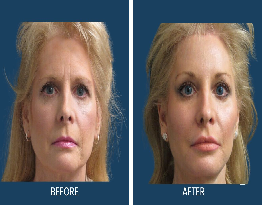
A brow lift can be performed using traditional or endoscopic techniques. Small incisions are made either along the hairline or behind the hairline, and the skin and muscles of the forehead are lifted and tightened. Recovery typically takes one to two weeks, with results lasting several years.
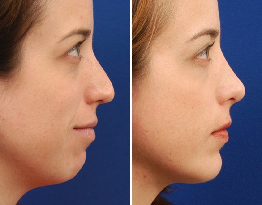
Chin augmentation is a procedure that enhances the shape and size of the chin, creating balance and harmony in the facial profile. It can be performed using chin implants or by reshaping the chin bone (sliding genioplasty). Chin augmentation is often combined with rhinoplasty to create a more proportional face.
Individuals with a weak or recessed chin
Patients seeking a more balanced facial profile
People looking to enhance the definition of their jawline
Chin augmentation is performed by making an incision either inside the mouth or under the chin. A custom-fit implant is inserted, or the chin bone is repositioned. Recovery takes about one to two weeks, with full results visible as the swelling subsides.
Otoplasty, or ear surgery, is a procedure that reshapes or repositions the ears to improve their appearance. It is commonly performed to correct prominent or protruding ears, as well as to address congenital deformities or trauma-related damage.
Individuals with prominent or asymmetrical ears
Patients looking to correct ear deformities
People seeking a more proportional appearance of the ears
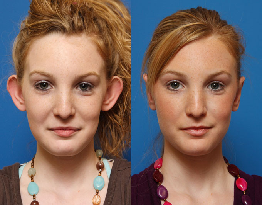
During otoplasty, incisions are made behind the ears, and the cartilage is reshaped or repositioned closer to the head. The procedure takes about one to two hours, and recovery typically takes one to two weeks.
For those seeking facial rejuvenation without surgery, there are several non-invasive cosmetic treatments available that can enhance your appearance with minimal downtime:
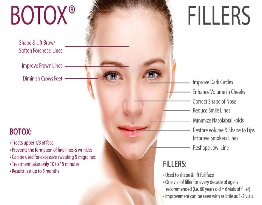
Botox and dermal fillers are injectable treatments used to smooth wrinkles, restore volume, and enhance facial contours. Botox relaxes the muscles responsible for expression lines, while fillers add volume to areas such as the cheeks, lips, and under-eye hollows. These treatments provide immediate results with no recovery time, making them popular options for those seeking subtle improvements.
Botox and dermal fillers are minimally invasive cosmetic procedures used to reduce wrinkles and enhance facial contours. Botox involves injecting a purified form of botulinum toxin into specific facial muscles to temporarily relax them, smoothing dynamic wrinkles such as crow’s feet and frown lines. The results typically last 3-4 months. Dermal fillers, on the other hand, involve injecting substances like hyaluronic acid beneath the skin to restore volume, smooth lines, and enhance facial features such as lips or cheeks. The effects of fillers can last from 6 months to 2 years, depending on the type of filler used. Both procedures are quick, often completed in under an hour, with little to no downtime.
Laser skin resurfacing uses advanced laser technology to remove damaged skin cells, stimulating collagen production and revealing smoother, more youthful skin. It’s effective for treating fine lines, wrinkles, scars, and uneven skin texture.
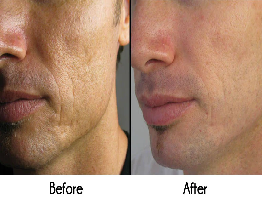
Laser skin resurfacing is a cosmetic procedure that uses concentrated laser beams to remove damaged outer skin layers and stimulate collagen production, improving the skin’s texture and appearance. It is commonly used to treat wrinkles, scars, sun damage, and uneven skin tone. During the procedure, the laser is carefully passed over the treatment area, targeting specific skin concerns. Recovery time varies depending on the intensity of the treatment, but the results can lead to smoother, younger-looking skin with reduced imperfections. The procedure is typically done in a dermatologist’s office with minimal downtime.
Selecting the right surgeon is crucial to achieving your desired facial surgery results. At Best Cosmetic Hospitals, we feature board-certified, internationally trained surgeons with extensive experience in facial surgery. Whether you're looking for a facelift, rhinoplasty, or non-surgical enhancement, our global network of experts ensures you receive the best care and results.
When choosing a cosmetic facial surgeon, consider:
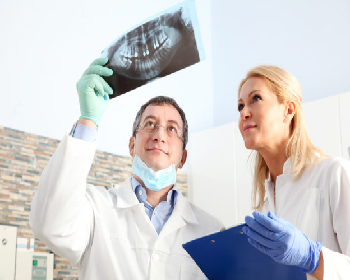
Look for a surgeon with significant experience in facial procedures, particularly the surgery you're interested in.

Reading reviews and examining before-and-after photos can help you understand the surgeon’s work and patient satisfaction.

A good surgeon will take the time to listen to your goals and provide a personalized treatment plan tailored to your needs.
At Best Cosmetic Hospitals, we are committed to helping you achieve your aesthetic goals with precision and care. Our global network of top surgeons offers you access to the best cosmetic facial surgery options, whether you're seeking a subtle enhancement or a complete transformation. Let us guide you on your journey to a more youthful, balanced, and confident appearance.